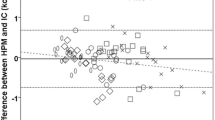Summary
A small (28 g) mechanical accelerometer has been tested by subjecting it to controlled bench tests consisting of repetitive vertical oscillations on two designs of test rig. The accelerometer's 3-digit display provided a cumulated score with a maximum of 99.9 units. This score was compared with an independent count of the imposed oscillations and found to be linear with time (r=0.996) and reproducible on retest (coefficient of variation=± 1.5%). The sensitivity ranged from 6.2 to 7.4 units/10,000 oscillations. The response was related to the maximal applied acceleration (calculated from the amplitude and frequency of the oscillations on the assumption that they were sinusoidal) and independent of the amplitude and frequency used. The threshold maximal acceleration was less than 2 m s−2 and the response had reached a plateau at 4 ms−2. During field studies the accelerometer was firmly attached over the hip in a waistband where it responded to the vertical accelerations produced by walking. When compared with an independent count of footsteps from a heel-mounted resistance pad the accelerometer score (after calibration) was not significantly different. The mean difference was (0.29±0.67, S.D.) 103 “steps” in a younger group (n=8, mean age 39 years) and (0.46±1.08, S.D.) 103 “steps” in an older group of women (n=6, mean age 65 years). Scores of around 10×103 “steps” can be expected in a day in moderately active young subjects and 40 × 103 “steps” in a week in the elderly. Simultaneously recorded scores from both right and left hips were not significantly different. In young subjects the mean difference was typically (1.08±0.8) 103 steps in a daily score of 10 × 103 steps and for old subjects (3.5±10.4) 103 steps in a cumulated 6 day score of 40×103 steps. The accelerometer can therefore be used as a pedometer to give an estimate of the number of footsteps taken over long periods.
Similar content being viewed by others
References
Benedict FG, Murschhauser H (1915) Energy transformations during horizontal walking. Carnegie Institute of Washington List publications No. 231
Barber C, Evans D, Fentem PH, Wilson MF (1973) A simple load transducer suitable for long term recording of activity patterns in human subjects. J Physiol 231:94–95P
Cavagna GA, Margaria R (1966) Mechanics of walking. J Appl Physiol 21:271–8
Cavagna GA, Saibene FP, Margaria R (1963) External work in walking. J Appl Physiol 18:1–9
Cotes JE, Meade F (1960) The energy expenditure and mechanical energy demand in walking. Ergonomics 3:97–119
Cunningham DA, Montoye HJ, Metzner HL, Keller JB (1968) Active leisure activities as related to age among males in a total population. J Gerontol 23:551–6
Gayle R, Montoye HJ, Philpot J (1977) Accuracy of pedometers for measuring distance walked. Res Quarterly 48:632–636
Irving JM, Patrick JM (1982) The use of mechanical pedometers in the measurement of physical activity. In: Stott FD (ed) Proceedings of the 4th International Symposium on Ambulatory Monitoring. Academic Press, New York pp 369–76
Kashiwazaki H, Inaoka T, Suzuki T, Kondo Y (1986) Correlations of pedometer readings with energy expenditure in workers during free-living daily activities. Eur J Appl Physiol 54:585–590
Kemper HCG, Verschuur R (1977) Validity and reliability of pedometers in habitual activity research. Eur J Appl Physiol 37:71–82
Masahiro Y (1982) Characteristics of spectral analysis of strides on treadmill walking. Ergonomics 25:496
Patrick JM, Bassey EJ, Irving JM, Blecher AB, Fentem PH (1986) Objective measurement of customary physical activity in elderly men and women before and after retirement. Q J Exptl Physiol 71:47–58
Saris WHM, Binkhorst RA (1977) The use of pedometer and actometer in studying daily physical activity in man. Eur J Appl Physiol 37:219–235
Sidney KH, Shephard RJ (1977) Activity patterns of elderly men and women. J Gerontol 32:25–32
Stunkard A (1960) A method of studying physical activity in man. Am J Clin Nutr 8:595–601
Washburn R, Chin MK, Montoye H (1980) Accuracy of pedometer in walking and running. Res Quart Exerc Sport 51:695–702
Author information
Authors and Affiliations
Rights and permissions
About this article
Cite this article
Bassey, E.J., Dallosso, H.M., Fentem, P.H. et al. Validation of a simple mechanical accelerometer (pedometer) for the estimation of walking activity. Europ. J. Appl. Physiol. 56, 323–330 (1987). https://doi.org/10.1007/BF00690900
Accepted:
Issue Date:
DOI: https://doi.org/10.1007/BF00690900




